The Strelitzia, commonly known as the Bird of Paradise Plant, is the spectacular, unmistakable and unchallenged Queen of the houseplant world. One look at it when it's in flower and you know where it got its common name; the flowers look incredibly like the head of a rather exotic crested bird.
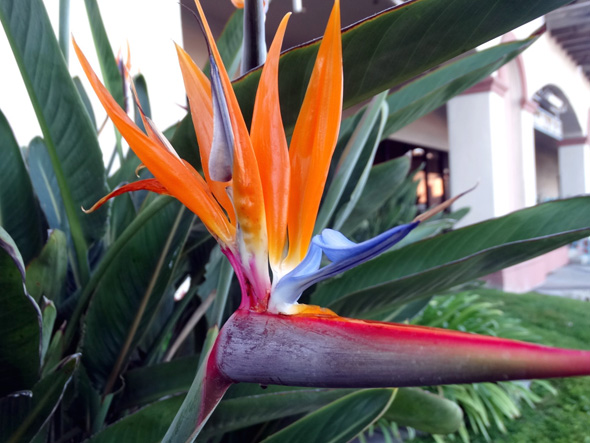
This photo by Don Graham perfectly captures the Strelitzia Flower in bloom
They're pollinated by sunbirds, which use the "beak" ledge on the flower as a perch. The weight of the bird on the "beak" opens it to release the pollen onto the bird, which is then deposited on the next flower it visits.
By using birds rather than smaller insects to do the pollinating it means as the plant ages and gets bigger rather than the plant producing ever increasing numbers of the same sized flowers, as you find in many other houseplants, what you'll notice is the blooms themselves tend to also get larger and larger.
The Strelitzia is the official flower of Los Angeles, although it originates from South Africa. It was named after an English Queen; Charlotte of Mecklenburg-Strelitz (1744 - 1818).
Queen Charlotte was an amateur botanist and when her husband King George III inherited the Royal Botanic Kew Gardens in 1772, it gave her the perfect chance to get her hands dirty and help with its development. The year after in 1773 Sir Joseph Banks brought back this spectacular new plant to Kew Gardens from South Africa, where it was officially named after Queen Charlottes family name; Mecklenburg-Strelitz.
There are five main species and varieties, although only Strelitzia Reginae and Strelitzia Nicolai are treated as houseplants.
S. reginae is very well known, and arguably the most common species (picture above). If the pot is big enough It can grow to 2 m / 6.6 ft tall, with large, tough banana like leaves 25–70cm / 9.8–28in long. They are produced on petioles (stems) up to 1m / 39in long.
The leaves are evergreen and emerge one at a time, usually in a criss cross pattern placement which ends up making a fan-shaped crown. The flowers are predominately orange with a touch of blue.
The most commonly found and recognised variety has the orange flower heads, although you can get a newer variety called S. reginae 'Mandela’s Gold' which is popular because it has yellow and blue flowers.

S. reginae 'Mandela’s Gold'
Yellow flowering Bird of Paradise plants had been around in the wild for a number of years. However the seeds from these yellow forms would not usually breed true when pollinated, simply because most would have been pollinated by different varieties with the orange flowers. To get a yellow variety that breeds true, two yellow parents are needed.
John Winter at Kirstenbosch National Botanical Garden (Africa) in the 1970's, pollinated their limited supply of yellow strelitzia's (they had only seven). By 1994 after twenty years of careful selection and hand-pollination they had increased the original seven to a large enough number to release it commercially.
It was originally sold and traded under the name 'Kirstenbosch Gold' until 1996 when the plants name was changed in honor of Nelson Mandela to become 'Mandela’s Gold'.
S. nicolai is another popular variety that has vivid white flowers and a black "beak". It was also named after Royalty (Nicholas I of Russia 1796 - 1855) however this one is considerably bigger than Queen Charlotte's plant, potentially reaching 6m / 20ft tall.
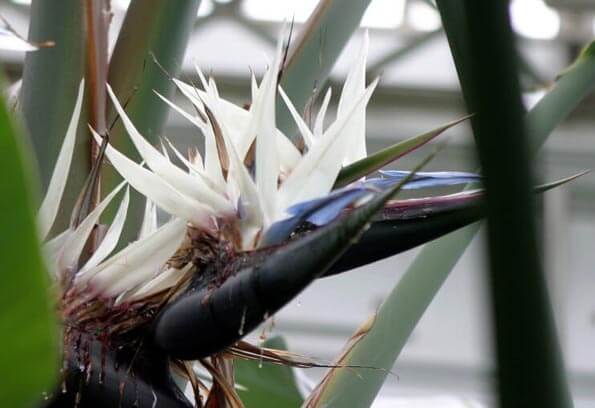
S. nicolai
The leaves as well as being bigger and longer than S. reginae's, tend to be shinier and greener. It's much harder to get S. nicolai to flower indoors and as you might imagine it takes considerably longer to reach its final mature height.
No matter how much you like the look of the white flowers of S. nicolai do not go looking for it unless you have the space to house it. It really does grow to an enormous size and because of the way all Strelitzia's grow it's impossible to prune the plant without killing it.
They always make a statement and the ultimate magnificence of a mature plant will command attention above everything around it
Both S. reginae and S. nicolai have much in common, including being named after Royalty, their majestic bold nature and being easy to grow.
We can't stress enough that these plants are truly spectacular, not just in their flowers but also in their eventual size. They always make a statement and the ultimate magnificence of a mature plant will command attention above everything around it.
This would be the perfect specimen plant or when space is at a premium but where you want just one plant with the "wow" factor. If you do fall in love with these plants they will completely dominate, and even after its long taken over you'll still be a happy subject of its rule.

Hi, I'm Tom!
If you're like me and enjoy the challenge of growing houseplants and getting them to thrive, then Ourhouseplants can help. This website shares my knowledge and years of growing plants and provides (hopefully) helpful advice on properly caring for your indoor plant friends.
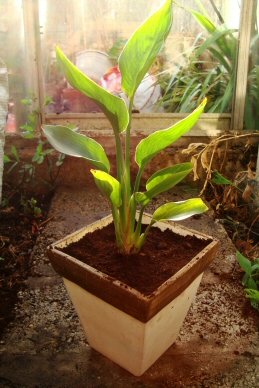 If you want lots of growth, and eventually flowers, it's going to need bright light and some sun. A east or west facing window should do. You'll also do well to pick a south facing window if some shielding is provided from harsh summer sun which can burn the leaves of immature plants.
If you want lots of growth, and eventually flowers, it's going to need bright light and some sun. A east or west facing window should do. You'll also do well to pick a south facing window if some shielding is provided from harsh summer sun which can burn the leaves of immature plants.
A north facing position ought to be avoided in the long term. Strelitzia's will cope with a darker position for a time, but growth will be much slower and the likely hood of flowers is low. You'll also get a more "spread" plant overall.
The amount of water needed will depend on where you end up putting your plant. Bird of Paradise plants in brighter, warmer spots are going to need considerably more than those in darker positions. A good rule of thumb is to water after the top of the soil becomes dry. Our favorite tip however is the weight of the pot trick. It's very easy to pick up a young plant and so this method works particular well.
If the air is very dry, an occasional misting would be helpful to aid in removing the dust that settles on the leaves.
Strelitzia's are typically hungry monsters, so plants which are rapidly growing need fertiliser once a month. Plants which are growing very slowly, so have little need for feed, cut back to bi-monthly instead. No feeding during the three or four Winter months is required.
Average home conditions would be fine, especially if you have chosen a brightly lit or Sunny spot. It needs warmth and some heat to grow well, although a cooler temperature between 8°C - 15°C / 46°F - 59°F in Winter is appreciated so the plant can "rest".
In the early years this is fine to do each Spring using normal potting compost, however if you want fflowers or you're trying to restrict the growth of the plant you need to keep it pot-bound. If it's housed in a plastic pot, a large Bird of Paradise will eventually distort and bulge it horribly. Therefore prepare to cut it free when it comes to repotting and know that when you do it will likely result in a disruption to the flowering cycle.
We used one of these plants as an example attempt in our Repotting guide if you want some more tips or tricks be sure to have a read of it.
Very mature Bird of Paradise plants will produce offsets which can be cut free and potted up, although this can be difficult. A more convenient method is to try and grow new plants from seeds. Like the flowers in which they are created, they are quite something with their largish seeds that have a tuff of orange hair. Pull off the hair, pot up in soil and place in a warm place.
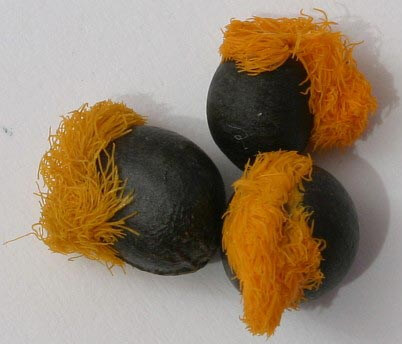
Germination is often erratic and unreliable but you can increase your chances by nicking the outer seed coat a tiny bit. This will allow water to move deep into the seed to trigger the germination.
The speed of Bird of Paradise growth in good conditions can be seen with roughly one new leaf each month during the growing seasons. Visually this may not seem much, but the thick roots beneath the soil surface are truly monstrous and will fill a pot in no time, making this quite a fast growing plant.
The plants will generally head for height rather than spread. S. reginae grows to 2m / 6.6ft tall. S. nicolai eventually reaches 6m / 20ft tall. However both types will flower long before they reach their eventual maximum heights.
If you're having problems getting the flowers then the following steps should hopefully help. 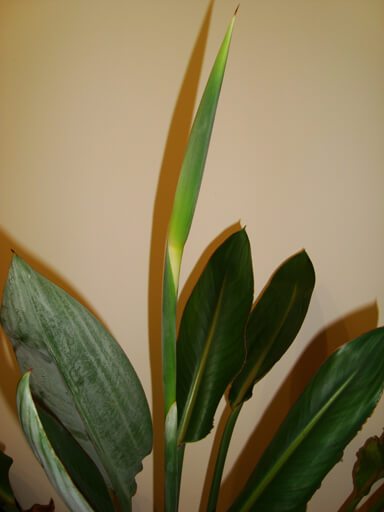 It's hard work for sure, but when you see that flower spike developing and slowly growing over several months to reveal the beautiful flower inside... It's a fantastic feeling for sure.
It's hard work for sure, but when you see that flower spike developing and slowly growing over several months to reveal the beautiful flower inside... It's a fantastic feeling for sure.
About all else patience is the key because these plants will flower when they decide to. You can encourage blooms, but ultimately we have no power to order a King or Queen to do anything quickly.
The Bird of Paradise is mildly toxic to pets such as cats and dogs. The poisonous compounds tend to be concentrated in the thick roots, the seeds and flower heads rather than the leaves.
The flowers last a long time so they're often worth the effort. If you get a seed pod when flowering finishes why not pot them up and give any seedlings away to family and friends.
As mentioned in our introduction, you can't easily prune a Bird of Paradise plant without ruining its look and future growth so all you can do is to be prepared to accommodate its large size. You can of course prune out the flowers once they are finished, just cut them off as close to the base as you can.
There isn't much that can keep Royalty down and therefore problems afflicting Bird of Paradise are normally rare.
No flowers on my Bird of Paradise
See the "Flowers" topic.
No growth
Strelitzia tends not to grow in Winter, in darker spots or just after a repotting (its energy is being spent growing its massive tap roots). 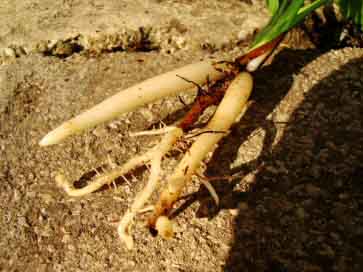 If none of the above applies, make sure the plant is being watered adequately, or that it's not in too small a pot. It's true you need to keep the plant pot-bound to make it flower, but it still needs a reasonably sized pot to let it grow to a potential flowering size in the first place.
If none of the above applies, make sure the plant is being watered adequately, or that it's not in too small a pot. It's true you need to keep the plant pot-bound to make it flower, but it still needs a reasonably sized pot to let it grow to a potential flowering size in the first place.
If you can cross off everything suggested above and the plant is otherwise healthy, leave it be and things should start up again in time.
A plant getting lots of light will produce new leaves which sit close to one another. A plant which is in a darker spot will produce leaves which are on longer petioles (the stem like part) and in more dispersed and wider positions. It does this to increase the leaf surface area exposed to light, in order to maximize the limited light it does receive. The simple fix is to provide more light so the newer leaves grow closer together.
Plant growth is weak
Many plants adapt well to living indoors as houseplants, but the Bird of Paradise suffers more than most if it's locked up inside all year around. They love spending at least a few weeks (months ideally) outdoors in the Summer. Being exposed to the elements harden's up the growth and will make your plant stronger. So if possible put it outside for a holiday.
Leaves curling on my Strelitzia
This is only normally seen in young plants. Although the adult plant likes bright light and some sun, the youngsters may struggle with it in the early years. When the light level reduces the leaves uncurl, but it's probably best to move to a slightly darker spot until it's older.
Leaves looking ugly and ragged
As a Bird of Paradise plant gets taller its perfectly normally for the bottom leaves to go brown, look ragged or even yellow up. The leaves don't tend to fall off by themselves for a long time, so you'll have to either pull them or cut them off.
If the upper leaves start to look in poor condition then its likely one of two things, far too much watering, or far too little. Assess which one it is and adjust your watering routine accordingly.
Credit for the Yellow "Mandela’s Gold" / "Kirstenbosch Gold" photo to Martin Addison
Credit for the picture of the Bird of Paradise seeds to Sebastian Stabinger